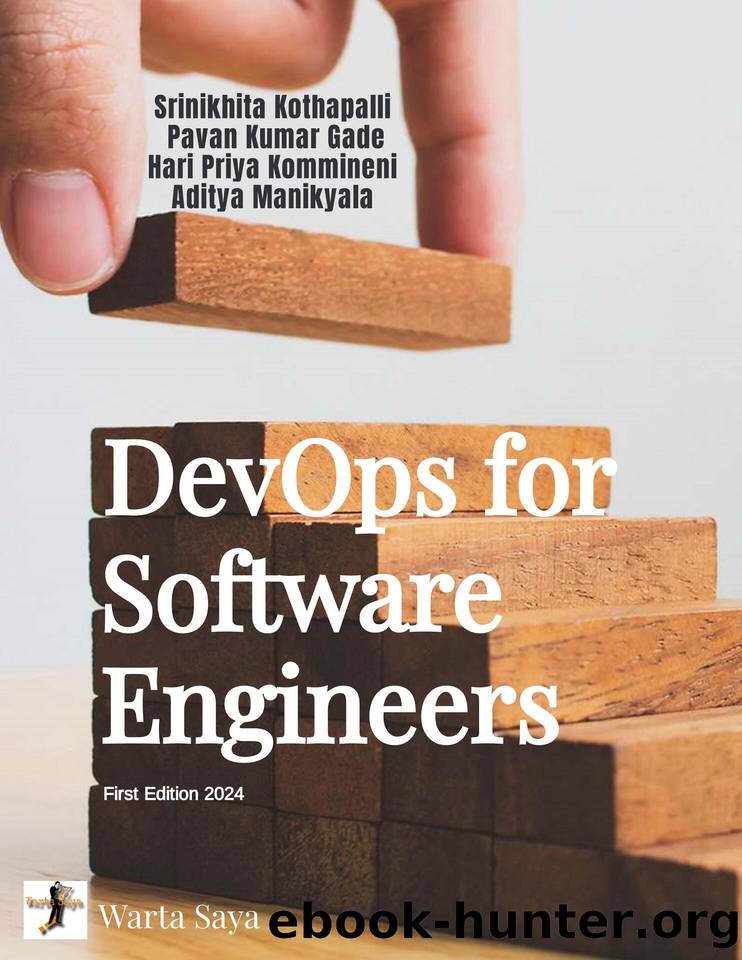DevOps for Software Engineers by Manikyala Aditya & Kommineni Hari Priya & Gade Pavan Kumar & Kothapalli Srinikhita

Author:Manikyala, Aditya & Kommineni, Hari Priya & Gade, Pavan Kumar & Kothapalli, Srinikhita
Language: eng
Format: epub
Publisher: Warta Saya, Kuala Lumpur, Malaysia
Published: 2024-08-27T00:00:00+00:00
SECURITY IN DEVOPS (DevSecOps)
Security principles are embedded throughout the DevOps pipeline, also known as DevSecOps, to guarantee that apps and infrastructure are safe. In conventional development approaches, security is often handled at the end of the development cycle, resulting in more complex and costly vulnerabilities. DevSecOps aims to "shift security to the left," which means that security is taken into account right from the start of the development process and is maintained throughout the application's lifespan.
INTEGRATING SECURITY INTO DEVOPS
For security to be integrated into DevOps, it must be seen as a shared duty by all team members, not only the purview of security teams. Developers, operations teams, and security specialists must work closely to identify possible risks and apply security measures in the development and deployment processes. Regular communication among all parties and cross-functional teams may facilitate this kind of cooperation.
The integration of security into DevOps is primarily dependent on automation. Automated security technologies may be integrated into CI/CD pipelines to accomplish static code analysis, vulnerability scanning, and compliance checks. With the aid of these technologies, security testing may be carried out effectively and consistently without impeding the development process. Teams may lower the risk of security breaches in production by identifying and fixing vulnerabilities early in the development cycle via security testing automation.
Another crucial component of DevSecOps is using security as code, in which security settings and rules are handled like code and controlled via version control systems. Using this technique, teams may implement security policies uniformly across development, production, and all other environments since security settings, such as application code, auditing, and compliance, can be monitored and examined, which is more straightforward.
Continuous monitoring and response are further components of integrating security into DevOps. Security teams should continually use technologies like intrusion detection systems (IDS) and security information and event management (SIEM) systems to monitor applications and infrastructure for possible threats and vulnerabilities. The response procedure to a security event should be as automated as feasible to limit and eliminate risks quickly.
Integrating security into DevOps requires a mix of automation, ongoing monitoring, and a cultural shift. By incorporating security principles across the DevOps pipeline, organizations may create more secure apps, lower the risk of breaches, and guarantee that security is integral to their development process.
Download
This site does not store any files on its server. We only index and link to content provided by other sites. Please contact the content providers to delete copyright contents if any and email us, we'll remove relevant links or contents immediately.
Deep Learning with Python by François Chollet(12881)
A Developer's Guide to Building Resilient Cloud Applications with Azure by Hamida Rebai Trabelsi(10218)
Hello! Python by Anthony Briggs(10131)
The Mikado Method by Ola Ellnestam Daniel Brolund(10020)
OCA Java SE 8 Programmer I Certification Guide by Mala Gupta(9988)
Dependency Injection in .NET by Mark Seemann(9524)
Hit Refresh by Satya Nadella(9001)
Algorithms of the Intelligent Web by Haralambos Marmanis;Dmitry Babenko(8532)
The Kubernetes Operator Framework Book by Michael Dame(8277)
Exploring Deepfakes by Bryan Lyon and Matt Tora(8066)
Practical Computer Architecture with Python and ARM by Alan Clements(8009)
Implementing Enterprise Observability for Success by Manisha Agrawal and Karun Krishnannair(7991)
Robo-Advisor with Python by Aki Ranin(7984)
Sass and Compass in Action by Wynn Netherland Nathan Weizenbaum Chris Eppstein Brandon Mathis(7921)
Grails in Action by Glen Smith Peter Ledbrook(7891)
Building Low Latency Applications with C++ by Sourav Ghosh(7874)
Svelte with Test-Driven Development by Daniel Irvine(7869)
Test-Driven iOS Development with Swift 4 by Dominik Hauser(7858)
Becoming a Dynamics 365 Finance and Supply Chain Solution Architect by Brent Dawson(7783)
